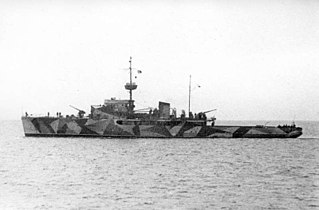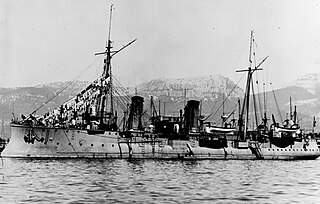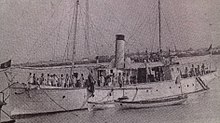
In naval terminology, a destroyer is a fast, maneuverable, long-endurance warship intended to escort larger vessels in a fleet, convoy, or carrier battle group and defend them against a wide range of general threats. They were originally conceived in 1885 by Fernando Villaamil for the Spanish Navy as a defense against torpedo boats, and by the time of the Russo-Japanese War in 1904, these "torpedo boat destroyers" (TBDs) were "large, swift, and powerfully armed torpedo boats designed to destroy other torpedo boats". Although the term "destroyer" had been used interchangeably with "TBD" and "torpedo boat destroyer" by navies since 1892, the term "torpedo boat destroyer" had been generally shortened to simply "destroyer" by nearly all navies by the First World War.

In late 19th-century naval terminology, torpedo gunboats were a form of gunboat armed with torpedoes and designed for hunting and destroying smaller torpedo boats. By the end of the 1890s torpedo gunboats were superseded by their more successful contemporaries, the torpedo boat destroyers.
HMS Peterel was one of two Spiteful-class destroyers to serve with the Royal Navy. She was built by Palmers, was 215 feet long and the 6,200 H.P. produced by her Reed boilers gave her a top speed of 30 knots. She was armed, as was standard, with a twelve pounder and two torpedo tubes. She served in home waters throughout the Great War and was sold off in 1919.

The Vifor class was a group of four destroyers ordered by Romania in 1913 and built in Italy during the First World War. The four ships were however requisitioned by Italy in 1915 and rearmed as scout cruisers (esploratori), subsequently seeing service in World War I. Two were re-purchased by Romania in 1920 and saw service in World War II. The other two were eventually transferred by Italy to the Spanish Nationalists and saw service during the Spanish Civil War.

NMS Amiral Murgescu was a minelayer and convoy escort of the Romanian Navy, the first sea-going warship built in Romania and the largest Romanian-built warship of World War II. She laid numerous minefields, from the Bulgarian port of Burgas to the Crimean port of Sevastopol, which inflicted significant losses to the Soviet Black Sea Fleet. She also carried out numerous convoy escort missions and took part in the Axis evacuation of the Crimea in May 1944. Due to her success in combat, she was decorated twice by May 1944. She was captured by the Soviet Union in September 1944 and served until 1988, when she was scrapped.

Pietro Micca was the first torpedo cruiser built by the Italian Regia Marina, and one of the first vessels of the type to be built by any navy. She was laid down in February 1875, launched in August 1876, and completed in July 1877. Details of her armament are contradictory, with various sources reporting a range of torpedo weapons, including a single 16-inch (406 mm) torpedo tube, a pair of tubes of undetermined diameter, and as many as six tubes. She proved to be unable to reach the projected speed of 17 knots, and so she did not see much active service. She remained in the Regia Marina's inventory until 1893, but spent most of her 16-year life in the reserve.

The Panther-class was a group of two torpedo cruisers, Panther and Leopard, built for the Austro-Hungarian Navy in the 1880s. The ships' primary armament was their four torpedo tubes, though they also carried a battery of medium and light-caliber guns. The ships were ordered in an effort to strengthen the defensive capabilities of the Austro-Hungarian Navy, during a period where funding for more expensive ironclad warships could not be secured from parliament. Since Austro-Hungarian naval designers did not have sufficient experience designing vessels of the type, the navy ordered the ships from the British Armstrong shipyard; work took from late 1884 to early 1886. After arriving in Austria-Hungary in 1886, the two ships served in a variety of roles. These included active duty with the main fleet in home waters, overseas training cruises, and showing the flag abroad. During World War I, the cruisers were mobilized for coastal defense duties, but saw no major action, apart from Panther shelling Montenegrin forces in 1916. After the war, both vessels were surrendered to Britain as war prizes and were broken up for scrap in 1920.

NMS Trotușul was a small torpedo boat of the Romanian Navy. Along with her three sister ships, she saw service during World War I and World War II, being the most successful vessel in her class.
During the Second World War, the Royal Romanian Navy operated a total of 9 submarines: three fleet submarines and six midget submarines. These vessels fought on the Axis side during the war. Only two of them survived the war and continued to serve in the Romanian Navy until the 1960s.
The Romanian Danube Flotilla is the oldest extant naval force on the Danube, dating since 1860, when the Romanian Navy was founded. It saw service during most of the wars involving Romania, and was the most powerful river naval force in the world during the Interwar period.

NMS Sborul was a torpedo boat of the Royal Romanian Navy. She was commissioned in 1920, after initially serving as Tb 81 T in the Austro-Hungarian Navy during World War I. She and six more sister ships were awarded to Romania as reparations after the war ended.

NMS Mircea was the second ship of the Romanian Navy's Black Sea Fleet, one of the Fleet's six founding warships and the only one of these vessels to remain in service until the Second World War. She was sunk during an air raid in April 1944.

The Bistrița class was a group of three small coastguard cruisers of the Romanian Navy. They served from 1888 until at least 1949.

The Troude class was a group of three protected cruisers built for the French Navy in the late 1880s and early 1890s. The class, which was very similar to the preceding Forbin class, comprised Troude, Cosmao and Lalande. They were ordered as part of a fleet program that accorded with the theories of the Jeune École, which proposed a fleet based on cruisers and torpedo boats to defend France. The Troude-class cruisers were intended to serve as flotilla leaders for the torpedo boats, and they were armed with a main battery of four 138 mm (5.4 in) guns.

The Forbin class was a group of three protected cruisers built for the French Navy in the late 1880s and early 1890s. The class comprised Forbin, Coëtlogon, and Surcouf. They were ordered as part of a fleet program that, in accordance with the theories of the Jeune École, proposed a fleet based on cruisers and torpedo boats to defend France. The Forbin-class cruisers were intended to serve as flotilla leaders for the torpedo boats, and they were armed with a main battery of four 138 mm (5.4 in) guns.

D'Iberville was the lead ship of the D'Iberville class of torpedo cruisers built for the French Navy in the 1890s. The class is also sometimes classified as torpedo gunboats or torpedo avisos. The D'Iberville-class ships were a development of earlier torpedo cruisers, with the chief improvement being a significantly higher speed. D'Iberville was armed with six 450 mm (17.7 in) torpedo tubes and a single 100 mm (3.9 in) gun as her primary offensive armament, though she had all of her torpedo tubes removed in 1896, just two years after entering service.

Casabianca was the third and final member of the D'Iberville class of torpedo cruisers built for the French Navy in the 1890s. The class is also sometimes classified as torpedo gunboats or torpedo avisos. The D'Iberville-class ships were a development of earlier torpedo cruisers, with the chief improvement being a significantly higher speed. Casabianca was armed with three 450 mm (17.7 in) torpedo tubes and a single 100 mm (3.9 in) gun as her primary offensive armament.

The D'Iberville class was a group of torpedo cruisers built for the French Navy in the 1890s. The class comprised three ships: D'Iberville, Cassini, and Casabianca.


















